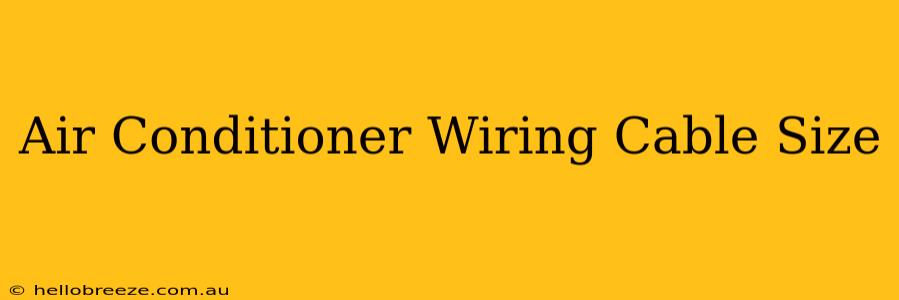Choosing the correct air conditioner wiring cable size is crucial for safety and efficient operation. An undersized cable can overheat, leading to fire hazards, while an oversized cable is wasteful and unnecessary. This guide will help you understand the factors influencing cable size selection and ensure you choose the right one for your AC unit.
Understanding the Factors Affecting AC Wiring Cable Size
Several key factors determine the appropriate size of the wiring cable for your air conditioner:
-
Amperage (Amps): This is the most critical factor. Your air conditioner's nameplate will specify its amperage draw. Never attempt to guess; always refer to the manufacturer's specifications. The cable must be rated to handle this amperage and the potential surge current when the compressor starts.
-
Voltage (Volts): AC units typically operate on either 120V or 240V. The voltage rating on the cable must match your AC unit's voltage requirement.
-
Cable Length: Longer cable runs experience higher voltage drop. A longer run necessitates a larger cable size to compensate for this loss.
-
Ambient Temperature: High ambient temperatures can affect the cable's current-carrying capacity. In hot climates, you may need a larger cable size to ensure safe operation.
-
Number of Conductors: The number of wires within the cable (e.g., hot, neutral, ground) also influences the overall cable size.
-
Installation Location: The cable's installation location (e.g., inside walls, conduit, direct burial) affects its required insulation and overall rating. Always follow local electrical codes.
Calculating the Required Cable Size
Calculating the precise cable size often requires complex calculations and an understanding of electrical codes. It's strongly recommended to consult with a qualified electrician. They can accurately assess your specific needs and ensure compliance with all safety regulations.
Do not attempt to perform these calculations yourself unless you are a qualified electrician. Incorrect calculations can lead to serious safety hazards.
Common Cable Sizes and Their Applications
While specific cable sizes depend on the factors mentioned above, here are some common sizes and their general applications:
-
10 AWG: Often suitable for smaller window units or some smaller split systems.
-
8 AWG: Commonly used for many standard window and split-system air conditioners.
-
6 AWG: Frequently used for larger split-system units and higher-amperage applications.
-
4 AWG or larger: Necessary for very high-capacity air conditioners.
It's crucial to remember that these are just examples, and your specific needs might differ.
The Importance of Professional Installation
Improper wiring can result in:
-
Electrical Fires: Overheating due to undersized wiring is a major fire hazard.
-
Malfunctioning AC Unit: Incorrect wiring can prevent your AC from working correctly or damage the unit's components.
-
Electrical Shocks: Faulty wiring can expose you to dangerous electrical shocks.
-
Voiding Warranties: Many AC manufacturers' warranties are voided if the unit isn't installed by a qualified electrician.
Always prioritize safety. Hire a licensed and experienced electrician to install your air conditioner's wiring. Their expertise ensures your system operates safely and efficiently. They can also provide you with the correct cable size based on your specific requirements and local electrical codes.
Keywords:
Air conditioner wiring, cable size, AC wiring, amperage, voltage, AWG, electrical wiring, HVAC wiring, air conditioning installation, electrical safety, electrician, home wiring, cable gauge, wire size, electrical code, AC unit wiring, sizing AC wiring, safe AC installation.

